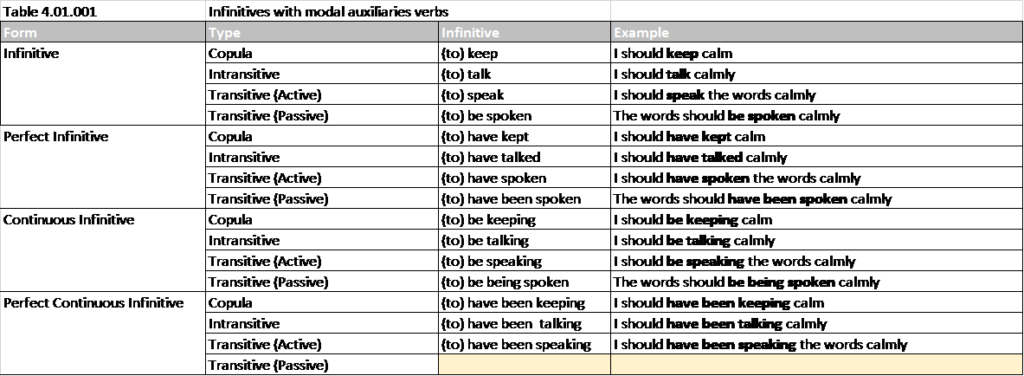Verbs come in both finite and non-finite forms.
A finite verb is the necessary component of every meaningful statement. Finite verbs are inflected to adapt to the grammatical subject. It is this bond between a single grammatical subject and a single finite verb that is the basic building block around which a statement is constructed. Finite verbs are analysed in section 6 below.
There are three non-finite forms, infinitives and present and past participles. The non-finite forms of a verb don’t adapt to the grammatical subject but do change to reflect the grammatical aspect and, in the case of transitive verbs, the grammatical voice. Infinitives, infinitives with past participles, and present participles in the form of gerunds can all function as noun-terms. These are analysed in section 5 below.
Non-finite forms are used with auxiliary verbs to create compound forms. Compound verbs are verb forms constructed using either an infinitive, present participle or past participle with an auxiliary verb. The auxiliary is the finite verb in the statement. The infinitive form is used with modal auxiliary verbs and the present and past participles are used to form grammatical tense, aspect and voice.
Infinitives with modal auxiliaries
There are seven infinitive forms. Infinitives can be used in both the bare form, without the particle to, and with the particle added. As part of the verb-term, the bare form is used.
The basic form is augmented to form the perfect, continuous and perfect continuous aspects. Grammatical aspect describes the way a state or event extends through time. This is not the same thing as tense, which locates the state or event in time relative to another point in time. In the case of the basic infinitive the extent through time is unspecified. In the perfect aspect the event that has been completed whereas in the continuous aspect the event is continuing. With transitive verbs there are three additional forms which are used in the passive voice.

The perfect continuous is an interesting construct. On the surface it would appear to be a contradiction. How can something be both completed and continuing? I think the answer is that rather than being a contradiction it creates an ambiguity by leaving open whether or not the event is continuing. If the continuous were used we would know the event is continuing; if the perfect were used we would know it is complete; however, if the perfect continuous is used it is left open whether or not the event is continuing. This can be useful when the situation is uncertain or a deliberate ambiguity is sought.
The perfect continuous isn’t possible in the passive voice. The logical form would be *to have been being spoken; however, *to have been being is a direct contradiction because to have been precludes being in a way that to have been doesn’t preclude speaking.
Present & past participles with auxiliaries
The two participles are used in compound forms of the verb with an auxiliary verb. The present participle is used to form the continuous aspect with to be as the auxiliary while the past participle is used with to have as theThe two participles are used in compound forms of the verb with an auxiliary verb. The present participle is used to form the continuous aspect with to be as the auxiliary while the past participle is used with to have as the auxiliary to form the prefect aspect and with to be as the auxiliary to form the passive voice.

This use of the past participle can create an ambiguity. For example, the window is broken could be interpreted as either a copula statement or as a transitive statement in the passive voice. If it is a copula it is saying something about the broken state of the window. If it is in the passive voice it is saying something about an event in which the window gets broken by an unspecified agent.
In other cases, the adjective is different from the past participle and the same ambiguity doesn’t occur. For example, the window is open is about the state of the window whereas the window is opened is about the event in which the window is opened.
